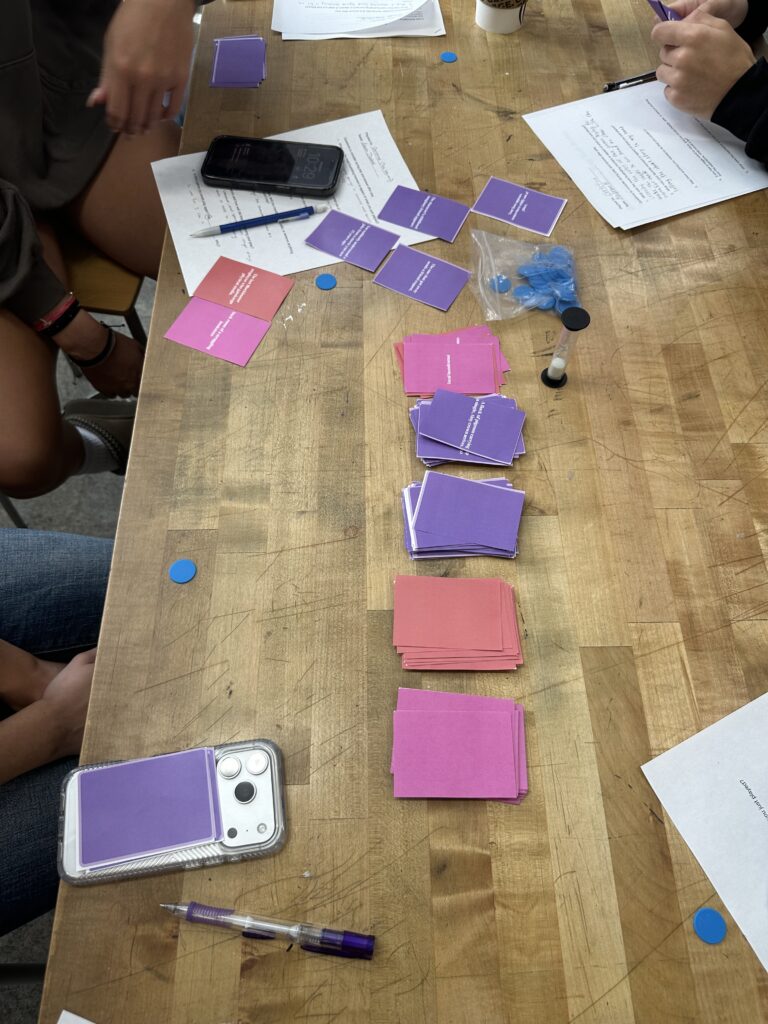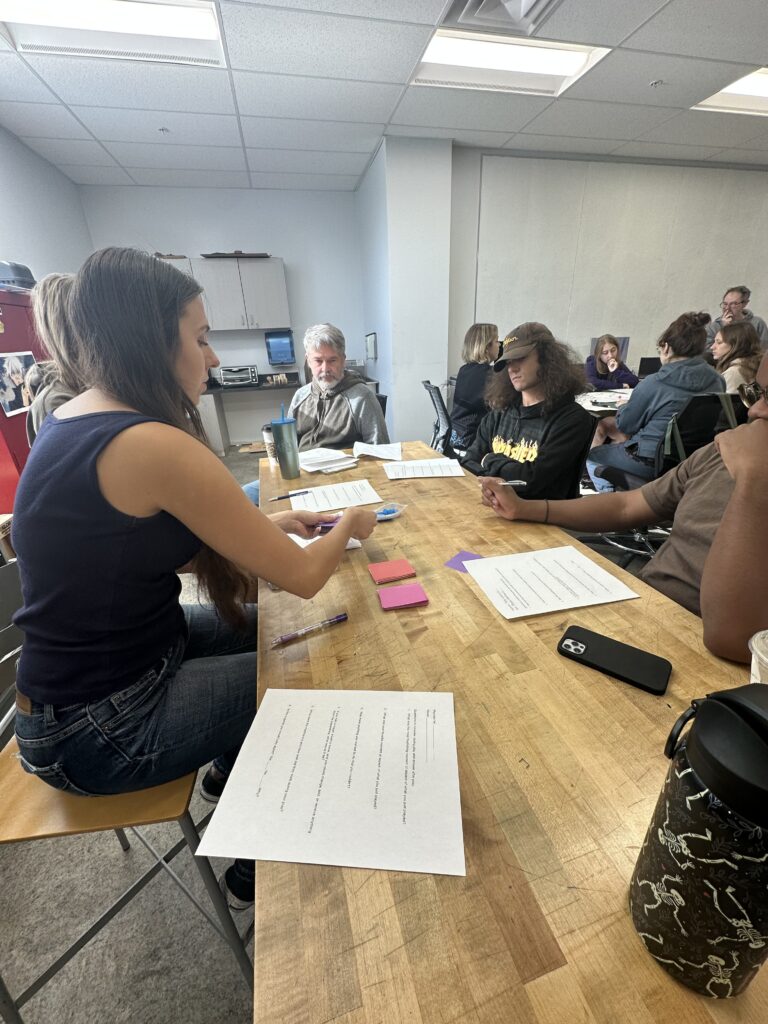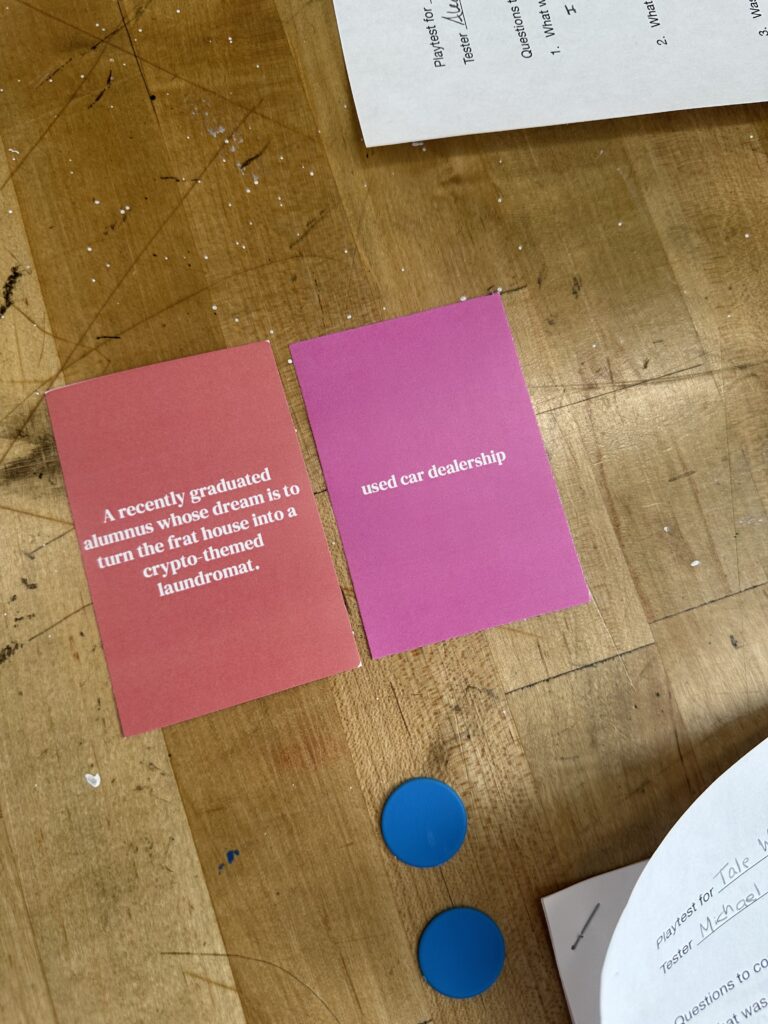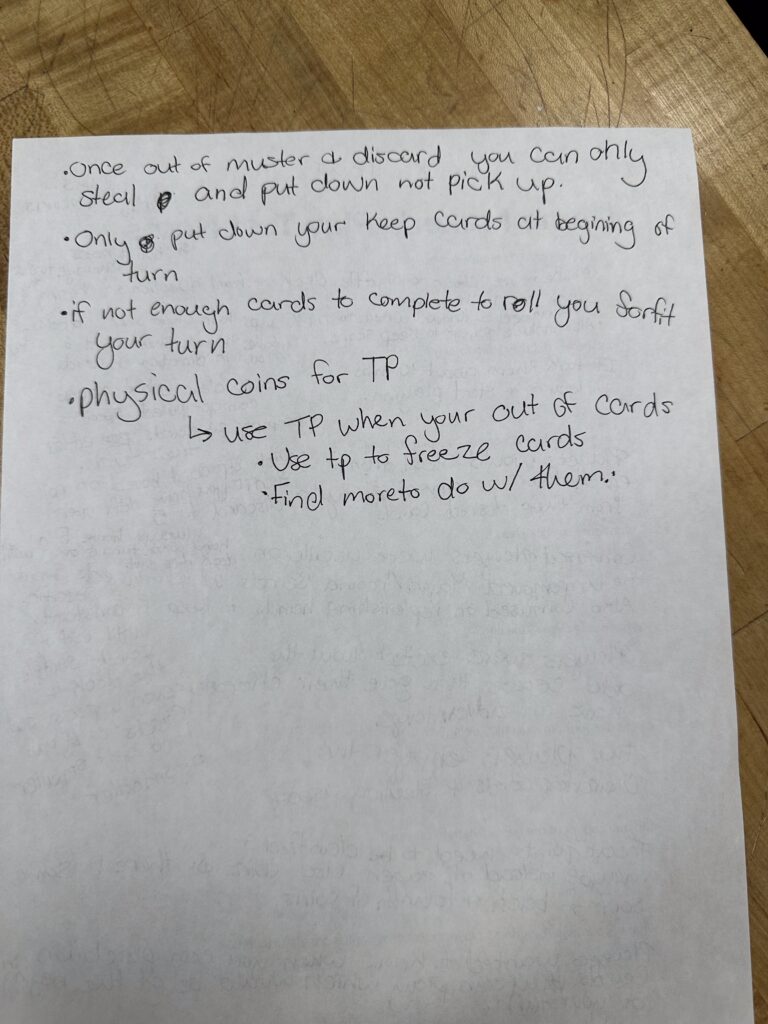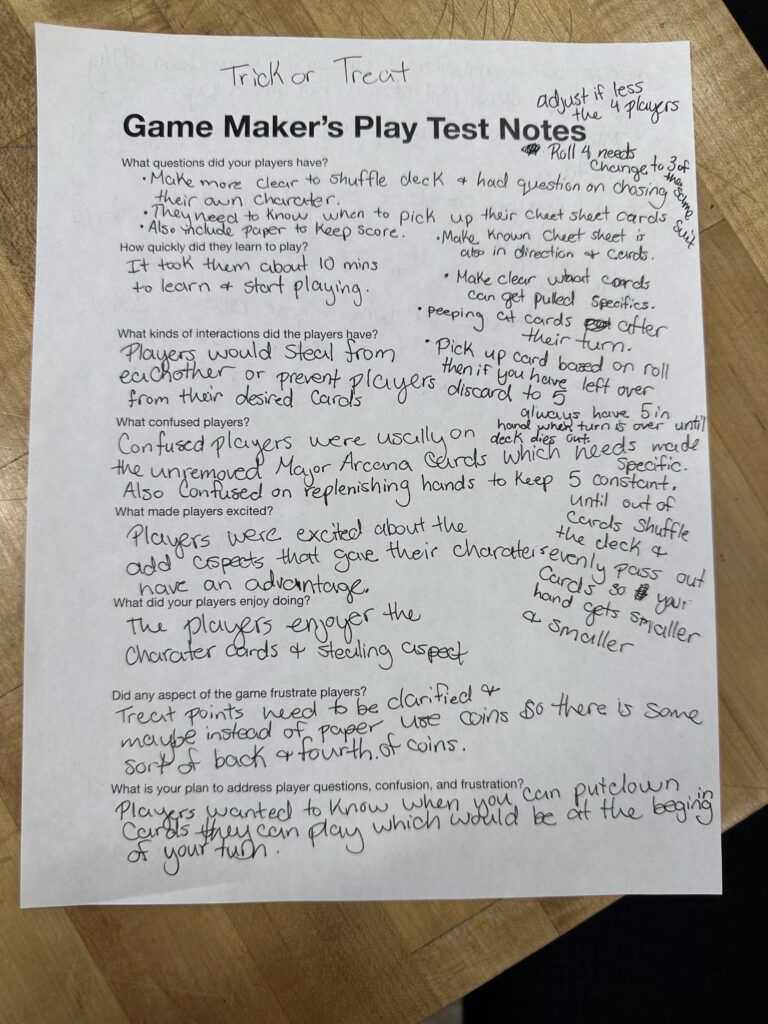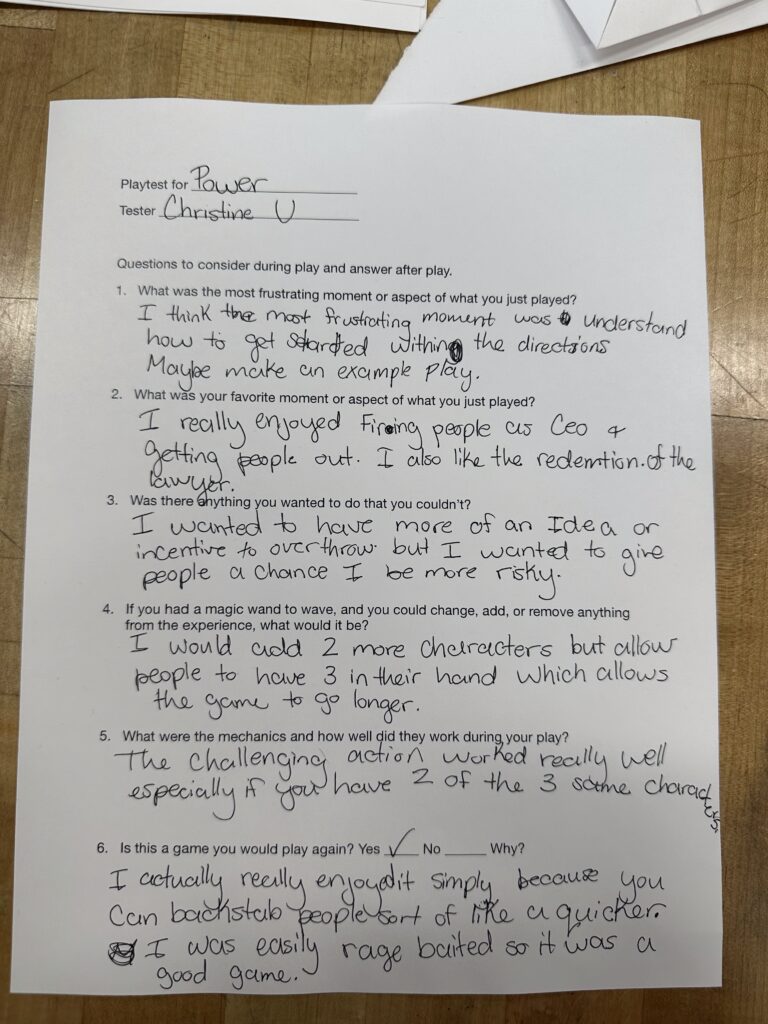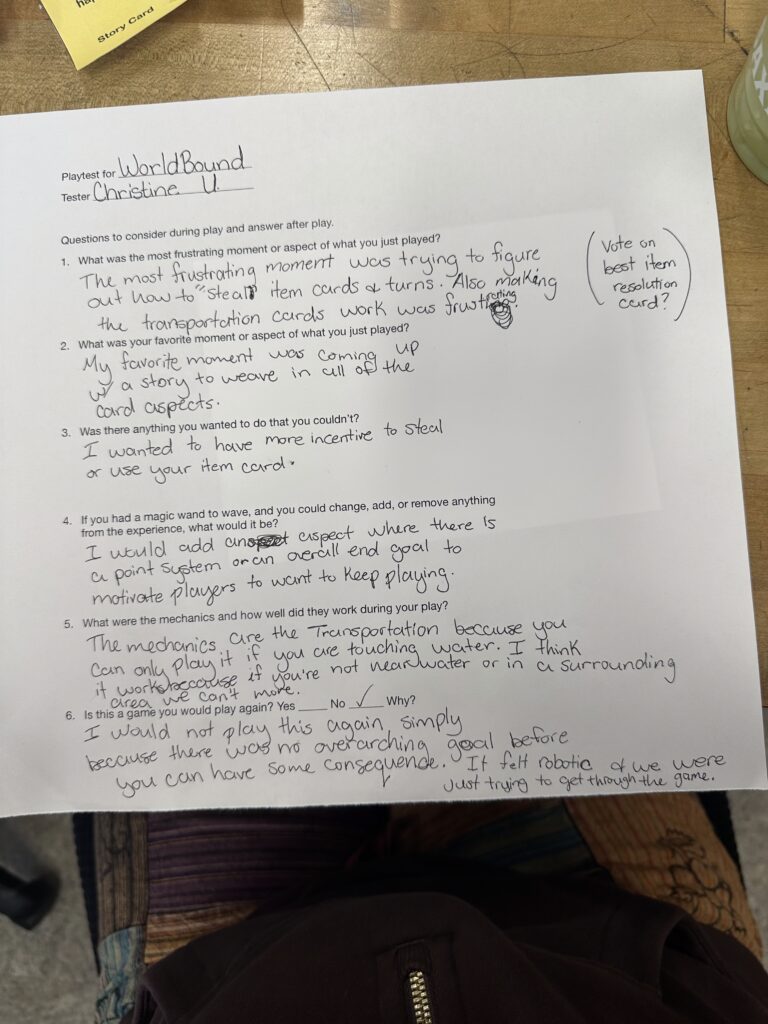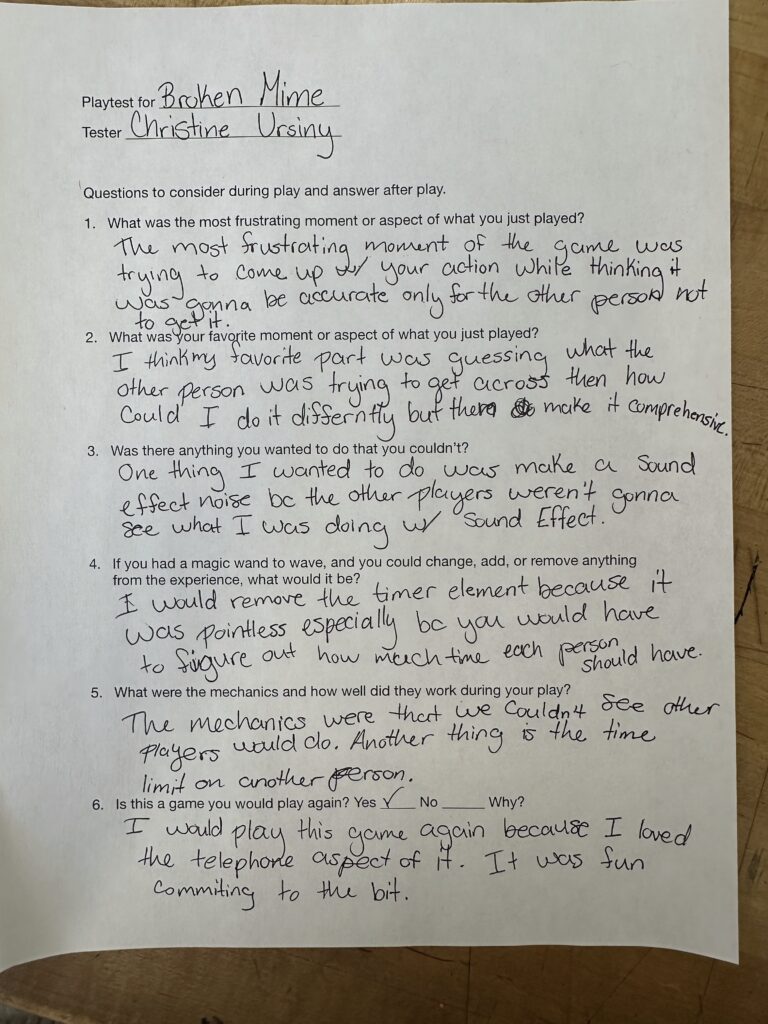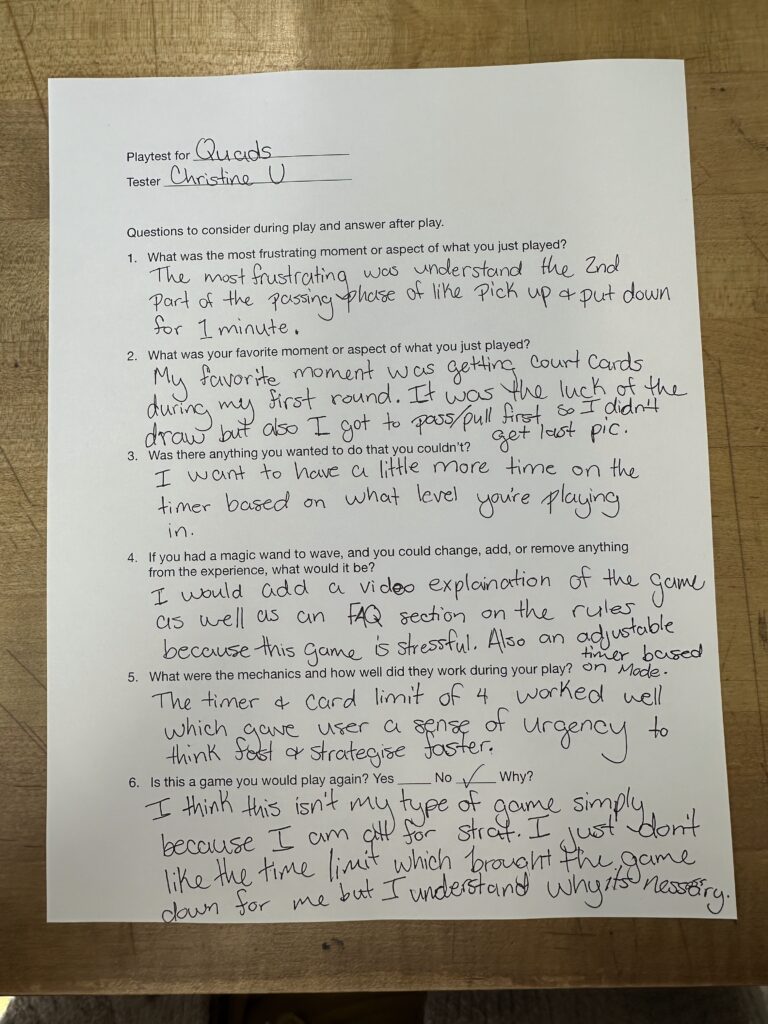Updated Rules for Trick or Treat
Game Play Observations to Improve – Trick or Treat
- Once out of the muster deck and discard deck, you can only steal and put down, not pick up.
- Only put down your Keep cards at the beginning of the turn
- If not enough cards to complete an action roll, you forfeit your turn
- Use physical coins for TP.
→ Use TP when you’re out of cards- Use TP to freeze other players from taking your cards
- Adjust the game if there are fewer than 4 players
- Roll 4 needs to change to 3 of the same suit instead
- Make it clearer to shuffle the deck and have something that allows players to know that when picking characters, you can’t choose those of the same element
- They need to know when to pick up their cheat sheet cards
- Change the treat Point paper with actual coins
- make known the cheat sheet cards in the directions, and the cards
- Make clear what cards get pulled specifically
- Make it clear in the directions that when allowed to be back, you would peek at the cards after you picked up
- Pick up a card based on Roll, then if you have left over, discard to five for your hand limit. Specifically, picking up after your turn is completed
- The hand limit no longer applies when both the discard and mustard decks are empty. Make sure to replenish your hands to keep a consistent five cards in your hand until both decks die out, then it is a free-for-all
- After the mustard deck is emptied and there is a discard deck left, make sure to shuffle the deck and use that as the new mustard deck until all cards are fully given out
- Three of one to be used and add more points to them, as far as what you can buy with treat points
- Make clear the order in which a player must play the game, with the first step being the roll and the last step being replenishing their hand.
Trick Or Treat Game Makers Playtest
Power Game Review
Worldbound Game Review
Player Centered Mindmap Directions
Pretty Directions
Game 3: The Trial of the Taming: Aspirant Handbook
Created by Christine Ursiny
1. The Game: Bond or Die
Welcome to The Eyrie, the cutthroat military academy where you and your fellow Aspirants have formed a Fated Bond with an ancient magical creature. This RPG is focused on high-stakes teamwork under pressure to graduate; you must survive the brutal, lethal trials of The Reckoning and work together to expose the dark secrets of the oppressive Staff.
2. Character Creation: Set Up
Step 1: Roll for Your Identity
Roll on the table below to determine your: Descriptor, Species/Skill, and Sector.
| Roll 1D6 | 1-2: Descriptor (Your Personality) | 3-4: Creature (Your Power) | 5-6: Sector (Your Academy Niche) |
| 1 | Rookie (Terrified, but fast) | Great Wyrm (Fire Breath, Burn) | Wing Leadership (Command & Tactics) |
| 2 | Washed-Up (Skeptical, but wise) | Gryphon (Piercing Shriek, Shatter) | Archives Guard (Security & Surveillance) |
| 3 | Unhinged (Aggressive, reckless) | Sky-Lion (Air Magic, Soar) | Scouting & Recon (Stealth & Intelligence) |
| 4 | Ambitious (Political, slick) | Drake (Heavy Armor, Shrug Off) | Healer/Scribe (Lore, Medicine & Support) |
| 5 | Reluctant (Relatable, empathetic) | Shadow Serpent (Illusion, Vanish) | Weapons Master (Gear & Melee Combat) |
| 6 | Grizzled (Experienced, damaged) | Tempest Owl (Lightning, Stun) | Logistics/Wartime Engineer (Supply & Defense) |
Step 2: Set Your Stats (The Bond)
You have two opposed stats. Both start at 3.
| Stat | Focus | When to use this stat… |
| RIDER | Discipline, Cunning, Control | Lying, persuading rivals, carefully piloting your creature, remembering academic lore, or solving puzzles. |
| BEAST | Instinct, Raw Power, Speed | Mauling, flying recklessly fast, using elemental magic, shrugging off damage, or terrifying enemies. |
3. Action Resolution
When you attempt an action and the outcome is uncertain and has real consequences, the Game Master (GM) will tell you which stat to use, and you roll a single.
- Succeed: If your roll is equal to or under the stat, you succeed!
- Fail: If your roll is over the stat, you fail!
The “Expert Edge” Rule (Specialized Skills)
If you use one of your character’s unique strengths, you get a significant edge:
- Creature Skill: If you invoke your Creature’s unique Species Skill (Burn, Shatter, Vanish, etc.), you may treat your BEAST stat as 4 for this single roll (even if it is lower or higher).
- Sector Niche: If you use an action directly related to your Sector (Weapons Master with gear, Archives Guard spotting a trap), you may treat your RIDER stat as 4 for this single roll (even if it is lower or higher).
4. The Shifting Bond (The Core Mechanic)
Your stats are never safe; they shift based on your successes and failures. Keep the two numbers balanced!
| Trigger | Effect on Your Stats | The Story Behind the Shift |
| Pride (Success) | Move 1 point from BEAST to RIDER | You succeed flawlessly through intellect and showboating. Your ego grows; you rely more on cunning. |
| Guts (Failure) | Move 1 point from RIDER to BEAST | Your plan fails, and panic or instinct takes over. You ditch tactics and rely on raw, animal survival. |
| Voluntary: Yell at your Creature | Move 1 point from RIDER to BEAST | You willingly give in to anger or fear, forcing your creature to obey. You gain wildness, but lose control. |
| Voluntary: Flashback to Study | Move 1 point from BEAST to RIDER | You interrupt the action to recall an academic insight, bringing logic to the chaos. You rein in your wildness. |
The End of the Line: When a Stat Hits 6
If either stat reaches 6, you have gone too far and are out of the game!
- RIDER reaches 6: You become corrupted by self-serving ambition. You betray your squad to join the oppressive Staff.
- BEAST reaches 6: You have completely Lost the Bond. Your creature flips out and rejects you. You are expelled (or killed).
5. Quick Q&A:
| Question | Answer |
| When do I roll? | Only when the outcome is uncertain and a failure would create a consequence (danger, lost time, etc.). |
| What happens if I fail? | The GM will give you a Narrative Setback (losing time, attracting Staff attention, your creature suffers a temporary trouble). A Stat Shift only happens if that failure triggers Guts (forces a panic response). |
| How does the Expert Edge work? | If you use your special skill, you treat your stat as 4 for that one roll. This is the simplest way to gain a powerful, reliable advantage without rolling extra dice. |
| Why is a high stat bad? | A high stat makes you better at those actions, but puts you closer to the End of the Line. A BEAST of 5 is an unstoppable force, but one failure could mean they lose their creature forever. |
| Who controls the creature? | You do! It’s an extension of you. If you want to fly carefully, that’s RIDER. If you want to use elemental fire, that’s BEAST. |
Honey Heist Review
1. Was it fun?
Yes, I enjoyed the storytelling aspect of it all while also the restrictions made by the GM and the character guide. It was ridiculous in the best way.
2. What were the player interactions?
The interactions between people were my character Lewis (a retired Black Bear thief) kept trying to hold the group together. Luigi, the koala muscle, was overly confident im biting peoples heads off but not very strategic. Labubu, the “Face,” flirted their way to get information that didn’t get anywhere. Bob, the blind honey badger getaway driver had no way to help and was only a hinderance. We were constantly bouncing off each other’s stories.
3. How long did it take to learn?
It was quick, the mechanics were easy, it took about 10 minutes to understand. The hardest part was wrapping our heads around how flexible we could be about improvising rather than understanding the system.
4. What was the most frustrating moment or aspect of what you just played?
The most frustrating part was how difficult the GM (BRYCE) made it to actually pull off the heist. Every time we got close to to something he would throw out everything to make it ridiculous. My character being on Ozempic and Flat Stanley got the most frustrating parts basically carrying the team.
5. What was your favorite moment or aspect of what you just played?
When the blind honey badger tried to drive the getaway van and just kept blasting highway to hell. Also just coming up with random stuff to do. It completely derailed the game but in the best way.
6. Was there anything you wanted to do that you couldn’t?
I wanted Lewis to actually get closer to the vault and overall get more context within the game to get to the honey but between the GM’s and the team we never got close.
7. If you had a magic wand to wave, and you could change, add, or remove anything from the experience, what would it be?
I’d balance the challenge a bit more so that players actually can succeed, which I guess all boils down the the GM. I wish the GM had more rules in general instead of it being impossible from the start.
Is this a game you would play again?
Yes
I would because even though we failed it was never not entertaining. I like the ability to have a completely different stort every time. I want to make a different verson of this type of game. The randomness keeps it fresh.
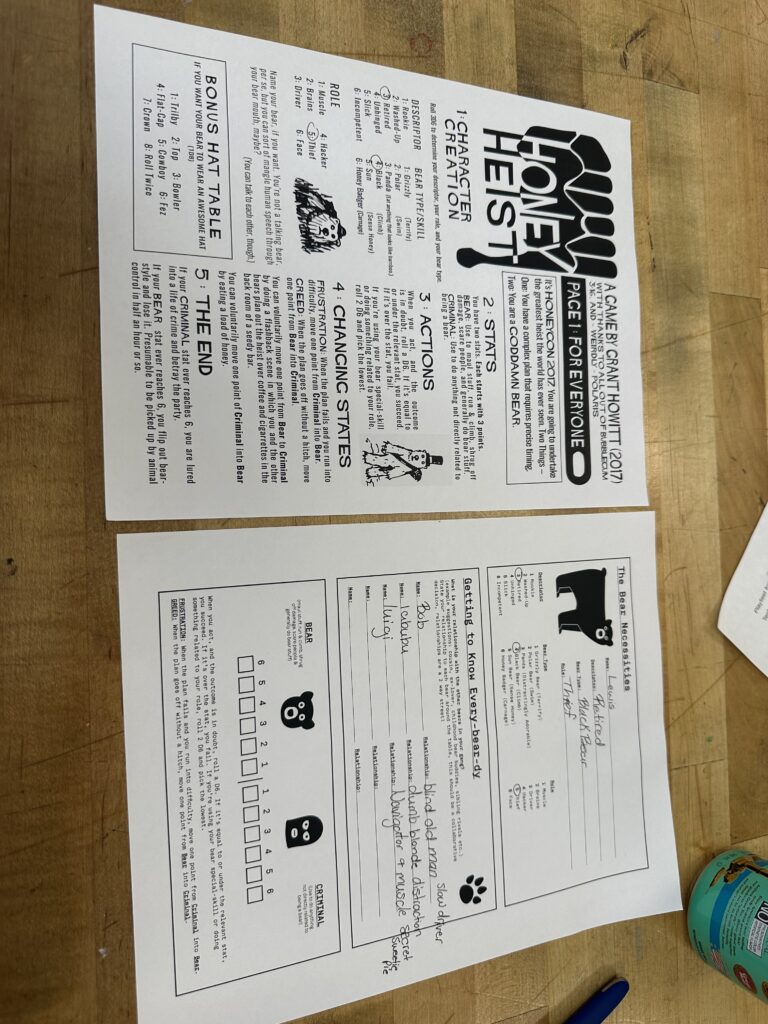
Broken Mime Review – Christine U
Game Review Quads – Christine U
Trick or Treat Game 2
Game Overview *The Following Condensed version of the game was summarized by ChatGPT*
The game is a race to complete a 10-card collection of your chosen suit. It blends strategic character selection with random six-sided dice-powered actions.
| Aspect | Summary |
| Objective | Be the first player to collect all 10 numbered cards of your suit (Imp, Bat, Ghost, or Pumpkin). |
| Materials | The 40 numbered Minor Arcana cards form the central Muster Deck. The 16 Court Cards (Prince/Knight/Queen/King) are used only for character drafting. You also use a single D6. |
| Starting State | Players draft one unique Court Card to become their character, which defines their goal suit and unique power. Each player starts with 5 cards in hand and 1 Treat Point (TP). |
How a Turn Works (The D6 Roll)
On your turn, you roll the D6, and the number determines what you must do:
| Roll | Action Type | What it Does |
| 1 or 6 | Draw | You get new cards from the Muster Deck. (Roll 6 lets you draw 3, but you must discard 2.) |
| 2 or 3 | Ask | You choose an opponent and ask for 2 (Roll 2) or 3 (Roll 3) specific cards. If they don’t have all the named cards, the request fails, and you only get 1 consolation card. |
| 4 | Fortify | You discard four cards of the same rank (ex., four Aces) to immediately gain 4 Treat Points. |
| 5 | Steal | You name one specific card (ex., “The 9 of Bats”) from an opponent. If you are right, you take the card and get 2 TP. If you are wrong, your turn ends immediately. |
The Key to Winning: Character Powers and Treat Points
Character Powers
The Court Card you draft (Page, Knight, Queen, or King) gives you a unique, scaled power that modifies the D6 actions for your suit:
- Imps (Action): Powers revolve around getting extra turns or free actions after a successful Steal (Roll 5). They are the most aggressive suit.
- Bats (Intellect): Powers upgrade your Ask (Roll 2/3) actions, letting you ask for cards by Rank (ex., “all your 5s”) or even by Suit (ex., “all your Ghost cards”), instead of naming specific cards.
- Ghosts (Emotion): Powers revolve around resource resilience. They gain Treat Points when they fail an Ask or when another player successfully Steals from them.
- Pumpkins (Material): Powers revolve around controlling the Muster Deck and gaining huge amounts of Treat Points from Draw actions (Roll 1/6) or guaranteeing a Draw by spending TP.
Treat Points (TP)
TP is your hidden weapon. Its primary use is to give you control over the card supply:
- Currency: You can spend 3 TP to perform a powerful Search action (once per turn) where you swap a card from your hand with any card in the discard pile. This is how you snag that one card you know your opponent got rid of.
- Tie-Breaker: In the extremely rare event that two players complete their 10-card set at the exact same moment, the player with the most Treat Points wins the game.
NEW UPDATED RULES – CHRISTINE URSINY
Tale Weavers: Official Rules
Game Description
Tale Weavers is a competitive storytelling game, with cards that you might find in Apples to Apples or Cards Against Humanity, in which a group of players builds a narrative by drawing from a deck of character, setting, and plot cards to create and build a story amongst players.
Objective
The main goal is to collaboratively build a story. The player who contributes the most compelling or humorous plot points, as judged by the Storymaster each round, wins the game. The player with the most successful Plot Cards, represented by Point Tokens, is the winner.
Setup
- Gather 3-5 players.
- Shuffle the Character, Setting, and Plot decks separately and place them face down.
- Deal five Plot Cards to each player. This is your starting hand.
- Place the Point Tokens in a central pile.
- Designate one player to be the Storymaster for the first round. (The player who most recently read a book for fun.)
- Use a 30-second sand timer to add urgency in selecting plot cards.
- 30-second timer → wait until the timer runs out to start the round
- Everyone has to have a card placed down by the end of the sand timer
- What happens when the timer runs out and you don’t pick? → You take the top card
Card Color Key:
Coral Color – Character Card
Magenta Color – Setting Card
Lavender Color – Plot Card
How to Play:
The game is played in rounds, with the role of Storymaster changing after each round.
1. The Storymaster’s Turn
- The Storymaster draws 2 cards from the Character deck and 2 from the Setting deck.
- They choose 1 Character and 1 Setting card from their hand to use and then discard the others.
- The Storymaster begins the story with an opening sentence or two, introducing the character and location.
Example:
If the Storymaster draws:
- Character Cards: “A paranoid mother” and “A surprisingly eloquent badger”
- Setting Cards: “The inside of a zoo food court” and “A wizard’s tower turned into a daycare”
- “Once upon a time, a paranoid mother who frantically scoured through the jungle known as the zoo food court…”
Note: Everyone has to have a card placed down by the end of the sand timer
2. The Players’ Turn
- Starting with the player to the Storymaster’s left and going clockwise, each player takes a turn.
- On your turn, place one Plot Card from your hand, play it face-up, and read it aloud.
- Weave the card’s concept into the story, building only on the setting and character card, not any other players’ plot cards
- Plot cards are independent of other players’ plot cards.
- After playing your card, draw one new Plot Card to replenish your hand to five.
3. The Storymaster’s Turn (Judgment)
- After every player has played one card, the Storymaster considers all the Plot Cards that were submitted.
- The Storymaster selects the most compelling or entertaining Plot Card as their favorite for that round.
- The Plot Cards that were not chosen are placed in a discard pile. If the draw deck runs out, shuffle the discard pile to create a new one.
4. End of the Round
- The player whose card was chosen collects 1 Point Token.
- The winning player becomes the new Storymaster for the next round.
- The new Storymaster can then decide to either continue the existing story or start a completely new one by drawing a new Character and Setting card.
Ending the Game
1. Point-Based Victory
- First player to reach 5 Point Tokens wins.
- Optional twist: If multiple players hit 5 in the same round, the Storymaster chooses the funniest/most creative winner.
Tale Weavers – Playtest 1
Date of Playtest: 10/02/2025
Playtime Observed: 6 minutes 25 seconds (first round)
Learning Time: 2 minutes 41 seconds (to learn rules)
1. Player Questions
- Does the story flow from player to player, or is it told individually?
- How do players weave their cards into the story, build on the last or reset each round?
- What happens when the timer runs out and a card hasn’t been played?
- Should a specific book be read to determine who goes first?
- How does the game end — tokens, alternate endings, or another system?
2. Learning Curve
- It took 2:41 minutes for players to learn the rules.
- Players commented that the setup was easy.
- The example card in the rules was helpful.
3. Player Interactions
- Players laughed, smiled, and nodded throughout gameplay.
- Conversations about cards applied to characters and settings.
- Debated whether the story should be told cumulatively or individually.
4. Points of Confusion
- Story flow: cumulative vs. sectioned/individual.
- How exactly to “weave” cards into a story.
- The role of settings in character and plot cards.
- Game endings: whether to use tokens or multiple end conditions.
5. Sources of Excitement
- Randomness of card draws (“random is better”).
- The tension created by a sand timer mechanic.
- Room for interpretation and creativity in storytelling.
- Loved leading humor in the narrative.
6. Player Enjoyment
- Making connections between cards and the story.
- Building individual story sections rather than a single collaborative plot.
- Experiencing humorous or unexpected story twists.
7. Sources of Frustration
- The collaborative story felt confusing and less engaging.
- Settings on cards felt restrictive.
- Multiple game-ending options created uncertainty.
8. Design Adjustments
- Clarify Flow
- Emphasize that each player tells an individual story, not a cumulative one.
- Simplify End Conditions
- Establish one clear win condition (ex., first to 5 tokens?).
- Refine Card Design
- Remove settings from character and plot cards; make prompts more open-ended and funny.
- Timer Rules
- Require players to place a card before the sand timer ends; if not, they must take the top card.
- Rules Support
- Keep and expand example cards in the rules to streamline learning.
